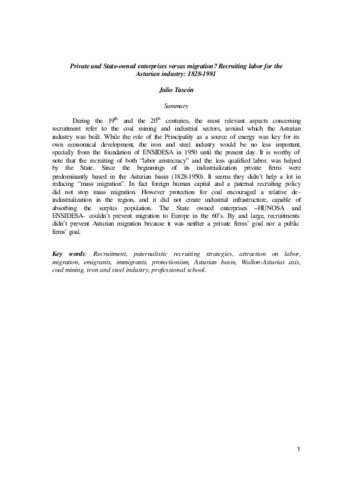Private and State-owned enterprises versus migration?: recruiting labor for the Asturian industry: 1828-1981
Autor(es) y otros:
Fecha de publicación:
Citación:
Resumen:
During the 19th and the 20th centuries, the most relevant aspects concerning recruitment refer to the coal mining and industrial sectors, around which the Asturian industry was built. While the role of the Principality as a source of energy was key for its own economical development, the iron and steel industry would be no less important, specially from the foundation of ENSIDESA in 1950 until the present day. It is worthy of note that the recruiting of both ¿labor aristocracy¿ and the less qualified labor, was helped by the State. Since the beginnings of its industrialization private firms were predominantly based in the Asturian basin (1828-1950). It seems they didn¿t help a lot in reducing ¿mass migration¿. In fact foreign human capital and a paternal recruiting policy did not stop mass migration. However protection for coal encouraged a relative deindustrialization in the region, and it did not create industrial infrastructure, capable of absorbing the surplus population. The State owned enterprises ¿HUNOSA and ENSIDESA- couldn¿t prevent migration to Europe in the 60¿s. By and large, recruitments didn¿t prevent Asturian migration because it was neither a private firms¿ goal nor a public firms¿ goal.
During the 19th and the 20th centuries, the most relevant aspects concerning recruitment refer to the coal mining and industrial sectors, around which the Asturian industry was built. While the role of the Principality as a source of energy was key for its own economical development, the iron and steel industry would be no less important, specially from the foundation of ENSIDESA in 1950 until the present day. It is worthy of note that the recruiting of both ¿labor aristocracy¿ and the less qualified labor, was helped by the State. Since the beginnings of its industrialization private firms were predominantly based in the Asturian basin (1828-1950). It seems they didn¿t help a lot in reducing ¿mass migration¿. In fact foreign human capital and a paternal recruiting policy did not stop mass migration. However protection for coal encouraged a relative deindustrialization in the region, and it did not create industrial infrastructure, capable of absorbing the surplus population. The State owned enterprises ¿HUNOSA and ENSIDESA- couldn¿t prevent migration to Europe in the 60¿s. By and large, recruitments didn¿t prevent Asturian migration because it was neither a private firms¿ goal nor a public firms¿ goal.
Ficheros en el ítem





